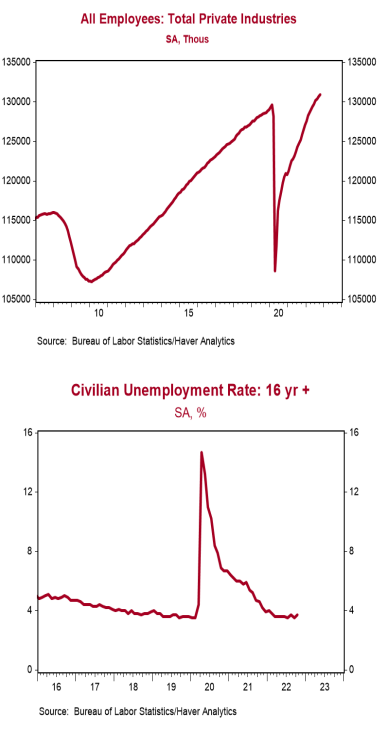- Nonfarm payrolls increased 261,000 in October, beating the consensus expected 193,000. Payroll gains for August and September were revised up by a total of 29,000, bringing the net gain, including revisions, to 290,000.
- Private sector payrolls rose 233,000 in October but were revised down 11,000 in prior months. The largest increases in October were for health care & social assistance (+71,000), professional & business services (+39,000, including temps), and leisure & hospitality (+35,000). Manufacturing increased 32,000 while government rose 28,000.
- The unemployment rate rose to 3.7% in October from 3.5% in September.
- Average hourly earnings – cash earnings, excluding irregular bonuses/commissions and fringe benefits – rose 0.4% in October and are up 4.7% versus a year ago. Aggregate hours increased 0.2% in October and are up 3.1% from a year ago.
Implications:
This is why you need to look beyond the headlines. Nonfarm payrolls rose 261,000 in October and were revised up an additional 29,000 for prior months, beating a consensus expected gain of 193,000. So far, so good. But please hold off on the champagne. Civilian employment, an alternative measure of jobs that includes small-business start-ups, dropped 328,000 in October while the labor force (people who are either working or looking for work) slipped 22,000. As a result, the unemployment rate rose to 3.7% versus 3.5% in September. Overall, these figures paint a job picture that’s not as bright as the headline gain in payrolls. Average hourly earnings increased 0.4% in October and are up 4.7% in the past year. In normal times those would be healthy figures, but these are not normal times. Consumer prices are up roughly 8.0% from a year ago, which means “real” (inflation-adjusted) hourly wages are shrinking. Because more people are working, the total number of hours worked are rising, by 0.2% in October and by 3.1% in the past year. Combined, total wages earned by all workers are up 8.0% from a year ago. What that means is that, in the aggregate, workers might be holding steady with inflation, but only because more people are working. On a per worker basis, real earnings are still falling. The bottom line is that the US is not in a recession yet, but the news about the labor market is not quite as positive as the payroll headline would suggest. So far this year, payrolls are up 407,000 per month. Look for a continued deceleration in the months ahead as companies start to anticipate slower economic growth and a possible recession in 2023.





